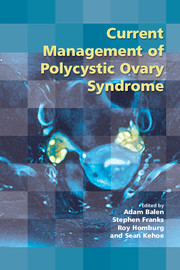
- Cited by 8
-
Cited byCrossref Citations
This Book has been cited by the following publications. This list is generated based on data provided by Crossref.
Child, Tim 2013. Textbook of Clinical Embryology. p. 161.
2013. Textbook of Clinical Embryology. p. 133.
Basheer, Muddasir Rai, Seema and Hsu, Tsai-Ching 2016. Melatonin vs. phytomelatonin: Therapeutic uses with special reference to polycystic ovarian syndrome (PCOS). Cogent Biology, Vol. 2, Issue. 1, p. 1136257.
Balen, Adam 2016. Polycystic ovary syndrome. InnovAiT: Education and inspiration for general practice, Vol. 9, Issue. 3, p. 144.
Balen, Adam 2018. Dewhurst's Textbook of Obstetrics & Gynaecology. p. 632.
Balen, Adam H. 2019. Subfertility, Reproductive Endocrinology and Assisted Reproduction. p. 106.
Balen, Adam H. 2019. Subfertility, Reproductive Endocrinology and Assisted Reproduction. p. 115.
Tsiami, Alexandra P. Goulis, Dimitrios G. Sotiriadis, Alexandros I. and Kolibianakis, Efstratios M. 2021. Higher ovulation rate with letrozole as compared with clomiphene citrate in infertile women with polycystic ovary syndrome: a systematic review and meta-analysis. Hormones, Vol. 20, Issue. 3, p. 449.
- Publisher:
- Cambridge University Press
- Online publication date:
- July 2014
- Print publication year:
- 2010
- Online ISBN:
- 9781107478343


